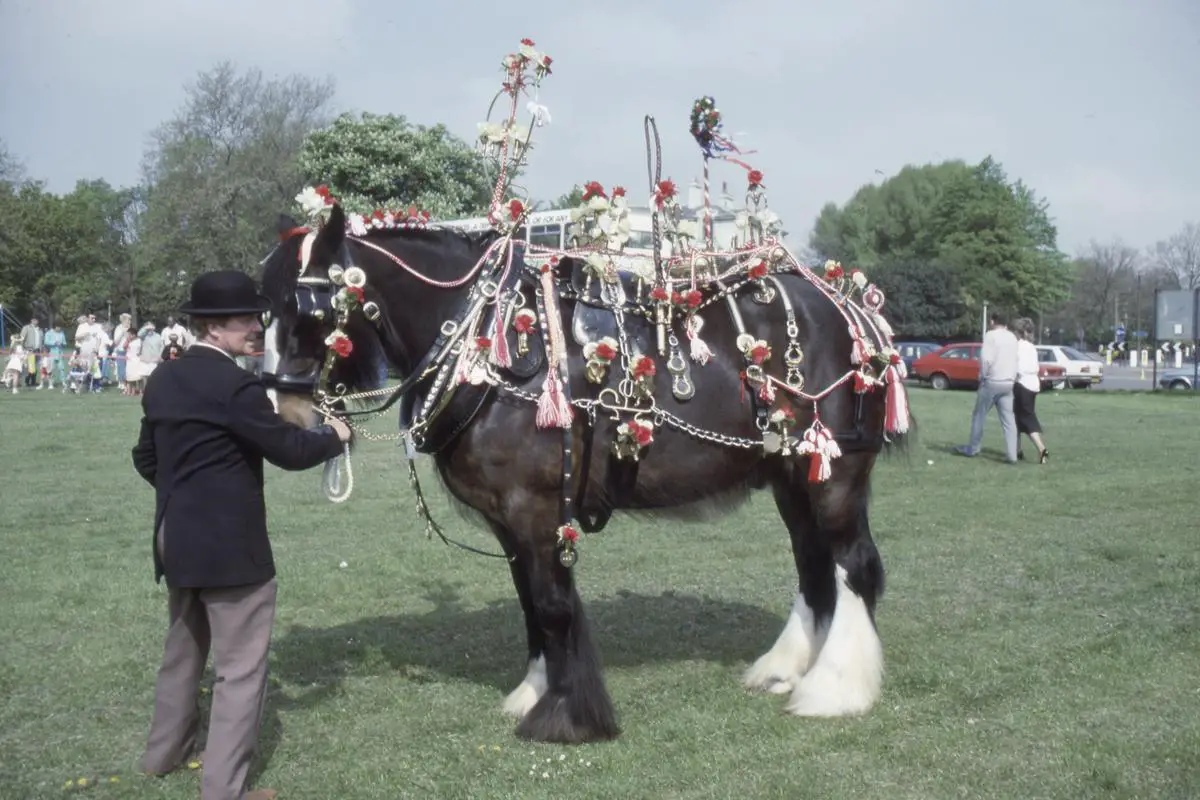Understanding the majestic Shire horse requires more than just a passing admiration for its imposing stature and unyielding strength. Comprehending this unique breed requires an investigation into its history, characteristics, and common uses, yielding an enriched appreciation for these gentle giants. Of particular interest is the exploration into the typical weight of Shire horses, as this significant facet offers valuable insights into their health, performance, and comparison with other breeds. As members of the general public or enthusiasts of the equine world, it becomes our responsibility to understand these creatures to their fullest capacity, not merely in adoration but in knowledge that aids their survival, growth, and welfare.
Table of Contents (Horspedia)
Understanding Shire Horse Breed
Understanding the Shire Horse Breed: An Overview
Rooted deeply in England’s agricultural background, the Shire horse breed stands as one of the largest and strongest horse breeds around the world. Introduced by the Normans in the 11th century, this draft horse aided in farming and warfare. Eventually, with the advent of industrialization, they became popular for pulling heavy loads in canal boats and freight wagons.
Characteristics of the Shire Horse Breed
The traits that dominate the Shire breed include their formidable size, robust strength, and gentle temperament. These horses display a natural aptitude for heavy work, giving an impressive combination of size and power. Physical attributes typically display broad backs, strong limbs, large hooves, and long feathering on the lower legs.
Shire horses’ coats can be black, brown, bay, or gray, occasionally accompanied by white markings. One standout feature is their large, expressive eyes, embodying their innate gentleness. Additionally, their height ranges between 16 to 18 hands (64 to 72 inches) for males, and 16 to 17 hands (64 to 68 inches) for females, making them a sight to behold.
Common Uses of the Shire Breed
Traditionally, the Shire breed was heavily relied upon for their exceptional strength and tireless work ethic. They were used vastly in farming, for tasks such as plowing fields and hauling heavy loads. With the onset of industrialization, their role shifted towards pulling wagons and canal boats. Today, their gentle character makes them suitable for riding and leisure activities, with some participating in shows, parades, and other exhibition events.
Shire Breed Weight Comparison
The weight of a Shire horse directly corresponds to its large stature and heavy bone structure. Typically, male Shire horses, known as stallions, weigh between 1,800 to 2,400 pounds, whereas female horses, known as mares, usually weigh between 1,600 to 2,200 pounds. These figures bear significant weight, literally and figuratively, as they put the Shire breed among some of the heaviest horses globally.
In comparison, other breeds such as the Thoroughbred or the Quarter Horse weigh significantly less. An average Thoroughbred ranges between 1,000 to 1,200 pounds, while a Quarter Horse usually weighs between 950 to 1,200 pounds. The discrepancy in weight clearly illustrates the superior size and strength of the Shire horse breed.
The Shire horse stands out among draft breeds because of its weight, power, and notably mild temper. These qualities make this breed perfect for tasks that require significant strength, both historically and in contemporary times.

Photo by anniespratt on Unsplash
Typical Weight of Shire Horses
An In-depth Look at the Typical Weight of Shire Horses
Recognized for their remarkable strength, endurance, and grand size, Shire horses are among the world’s largest horse breeds. These magnificent creatures, which originated in England, are revered for their strong capability to haul or carry enormous loads.
In discussing the average weight of Shire horses, it’s crucial to note the variation in their sizes. Regardless, the standard weight of an adult Shire horse typically lies anywhere between 1,800 and 2,400 pounds. Mature males, or stallions, can surpass this range, potentially weighing as much as 2,600 pounds. Female Shire horses, or mares, tend to be somewhat lighter, with their average weight fluctuating between 1,600 and 2,100 pounds.
Factors Influencing Weight in Shire Horses
Several factors come into play when determining the weight of a Shire horse, ranging from their age, gender, diet to their overall health.
Age and Gender
As with most living creatures, the age and gender of a Shire horse significantly influence their weight. Juvenile or adolescent Shire horses weigh less compared to their full-grown counterparts, where weight accumulation comes as they grow and mature.
As mentioned earlier, male Shire horses typically outweigh the females. This larger size can be attributed to their roles in breeding and competition where larger, stronger males are favored.
Diet
The diet is another critical component in a Shire horse’s weight. Due to their massive size, Shire horses require a significant amount of food to maintain a healthy weight. Generally, they are fed a combination of forage, such as hay or grass, and grains. Falling short in providing sufficient nutrients can result in underweight horses, while overfeeding can lead to obesity.
Health Conditions Influencing Weight
The weight of Shire horses can be significantly impacted by various health conditions. For instance, these robust giants can become overweight or even obese, leading to potential complications like laminitis or equine metabolic syndrome. On the other hand, certain ailments such as dental diseases, parasitic infections, or chronic illnesses may cause them to lose weight.

Comparison with Other Breeds
A Sizeable Breed: Shire Horse Weight in Comparison to Others
Originating from the United Kingdom, the Shire horse is known for its extraordinary size and strength. Typically weighing between 1,800 to 2,400 pounds, this breed is considered one of the heaviest and most powerful. When compared to other horse breeds, the Shire stands as a large and impressive benchmark, reflecting the remarkable heft and stature for which these horses are known.
Comparisons with Equally Popular Breeds
When placed beside the average American Quarter horse, a breed celebrated for speed and agility, the higher weight of Shire horses becomes clearer. The American Quarter horse typically weighs between 950 and 1,200 pounds – extraordinarily lighter than their Shire counterparts.
In comparison to the Arabian breed, known for endurance and a strong bone structure, the Shire horse remains a cut above. An Arabian horse generally weighs between 800 and 1,000 pounds, a far cry from the massive weight of the Shire breed.
The Shire vs Larger Breeds
Even when pitted against some of the larger breeds such as the Clydesdale, famed for their impressive size and strength, the Shire horse holds its own. Clydesdales usually weigh between 1,600 and 2,200 pounds, which is on the lower spectrum of the Shire’s weight range.
However, it is the Belgian Draft horse breed that comes closest to the Shire in terms of weight. Renowned for their massive build and immense power, Belgian Draft horses commonly weigh between 1,800 and 2,200 pounds. Yet, some Shire horses have been known to exceed this weight, reaching up to a whopping 2,400 pounds.
Shire Horse Weight Overview
The Shire horse, acclaimed as one of the heaviest horse breeds globally, boasts a staggering weight unmatched by most other breeds. When compared to lighter horse breeds like the Arabian or American Quarter horse, the Shire horse’s sheer mass is undoubtedly remarkable. Even more impressively, the Shire often outweighs larger breeds such as the Clydesdale and Belgian Draft horses, standing as a truly unique and awe-inspiring breed in the equine world.

Impact of Weight on Shire Horses’ Health and Performance
An Insight into the Massive Size of Shire Horses
Regarded for their colossal sizes and formidable physique, Shire Horses are predominantly utilized for hauling hefty loads, be it in urban or country settings. As one of the world’s largest horse breeds, a mature Shire Horse on average weighs between 1,800 and 2,400 pounds, though some impressive individuals have been known to tip the scales at as much as 2,800 pounds.
Impact of Underweight on Shire Horses’ Health
While a shire horse’s large size and robust constitution allow them to carry weighty loads, maintaining a healthy weight is essential to their wellbeing. Underweight horses, despite their bulky appearance, can have various health issues like suffering from a compromised immune system, which makes them more susceptible to diseases and infections.
Being underweight can also affect a Shire Horse’s performance. Horses in this condition may lack the necessary stamina to perform tasks, as they’re functioning without the necessary energy reserves from body fat. Continuous work without appropriate fuel from food can lead the animal to break down body tissues for energy, leading to a loss in muscle mass over time.
Importantly, underweight conditions sometimes indicate underlying health problems, such as dental issues or parasitic infestations that restrict nutrient absorption, requiring a veterinary intervention for proper diagnosis and care.
The Side-Effects of Overweight Conditions on Shire Horses’
On the other hand, Shire Horse that is overweight can also face significant health and performance challenges. Excessive weight can put increased strain on the horse’s joints, muscles, heart, and lungs, leading to decreased comfort and possibly contributing to longer-term issues like arthritis or heart disease.
Moreover, overweight horses often show reduced performance capacity due to decreased endurance and an overall sluggish demeanor making them less capable of carrying out their typical work tasks. Moreover, overweight conditions place the horse at an increased risk for developing conditions like Equine Metabolic Syndrome (EMS) and laminitis, a painful and potentially severe disorder affecting the horse’s feet.
A Balanced Approach to Shire Horses Weight Management
Ensuring a Shire horse maintains a healthy weight involves a balanced diet, regular exercise, and consistent veterinary care. A nutritious meal plan which considers their age, workload, metabolism, and specific needs is integral. Incorporating regular physical activities will help keep their muscular build in top form, while frequent vet visits can detect and address potential weight-related issues early on.
The size and strength of Shire Horses are notable features, but it is crucial to keep their weight within the breed’s typical range for their overall health and performance. An appropriate balance is key, with the aim being to avoid both underweight conditions that drain them of necessary energy, and overweight situations that place undue stress on their joints and organs. Ensuring this balance requires consistent monitoring and care to keep these impressive creatures in optimum health.

Maintaining Healthy Weight in Shire Horses
Comparing the Weight of Shire Horses: The Significance of a Healthy Body
Originating from England, Shire horses, a draught horse breed, are famous for their imposing size and strong physique. An adult Shire horse typically weighs between 1,800 and 2,400 pounds which greatly exceeds the average weight of numerous other horse breeds. Given their substantial size and weight, it’s essential to ensure they maintain a healthy body condition as it crucially impacts their overall wellbeing.
The Role of Proper Feeding
The quality and quantity of food provided to a Shire horse directly impact its weight and health status. Due to their size and work load, Shire horses require a balanced diet, rich in good-quality forage and protein, to maintain their weight and muscle mass. Over- or under-feeding can result in significant weight fluctuation, leading to health issues.
Owners should avoid rapid changes in diet and ensure their Shire horse is getting enough fiber, which not only maintains a healthy digestive system but also prevents overeating. The use of a body condition scoring system can help gauge if the Shire is at its appropriate weight, by considering areas of fat deposition and muscle tone.
Importance of Regular Exercise
Just like for humans, regular exercise is key to maintaining a healthy weight for Shire horses. Due to their working background, shires are used to rigorous physical tasks and can easily become overweight and unhealthy if left inactive.
An exercise regimen tailored to the Shire’s age, physical condition, and professional uses is necessary. Firm ground work, long rides, and regular tasks that engage their strength can help maintain their weight, muscle tone, and overall fitness.
Regular Veterinary Check-Ups
Although owners can play an active role in spotting the signs of overweight or underweight issues, regular veterinary check-ups are crucial. Vets can offer a professional and objective point of view on a Shire horse’s weight and overall health condition.
Routine vet check-ups allow early detection and necessary intervention in case of weight-related health issues. These include metabolic problems, joint issues, and laminitis, a painful hoof disorder that shire horses can be more susceptible to if overweight.
In conclusion, while it’s normal for Shire horses to be heavier than many other breeds, it’s important for owners to manage their weight effectively. By ensuring the right diet, providing regular exercise, and scheduling routine vet checks, maintaining a healthy weight for a Shire horse is achievable. The ultimate goal is to ensure good health, a profitable working life, and a good quality of life for these magnificent creatures.

Through the comprehensive understanding of Shire horses, we realize that their weight, in comparison to other breeds, reveals a great deal about their stature, health and overall capabilities. However, it is not enough to only catalog their weight but also to maintain it for the benefit of their health and performance. With the right mix of proper feeding, wellness care, and regular check-ups, a balance can be achieved that ensures these horses thrive in their environments. It is in recognizing the intricacies of their breed and providing adequate care, that we affirm our commitment to the welfare of these majestic creatures and contribute to the enduring legacy of the Shire horses.